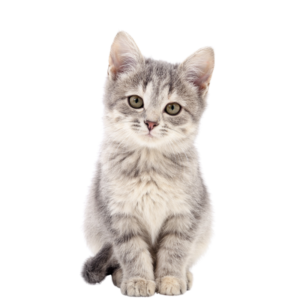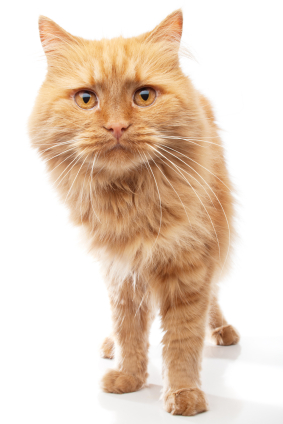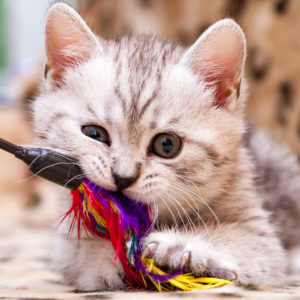The urinary tract consists of the kidneys, ureters, bladder and urethra. The kidneys filter waste products from the blood and then concentrate the filtrate to form urine in order to conserve water. The ureters carry the urine from the kidneys to the bladder. The bladder is a muscular sac that stores the urine until such time as the cat chooses to empty it. The urethra carries urine from the bladder to the penis or vulva for elimination from the body.
This information deals with disease of the bladder and urethra which comprise the Lower Urinary Tract. Most lower urinary tract disease starts in the bladder and is usually accompanied by some discomfort. This can manifest itself by frequent visits to the litter box, crying when attempting to pass urine, blood in the urine or inappropriate urination (Not passing urine in litter box but in other parts of the house or on furniture). The discomfort is usually caused by inflammation of the wall of the bladder and the medical term for this is Cystitis ( ..itis means inflammation).
Cystitis can be caused by several different diseases. 1. The least common and worst of all is cancer of the bladder wall. This usually only occurs in older cats. 2. Bladder stones can also occur in cats and cause cystitis partly because of their abrasive consistency. 3. Small bladder stones can sometimes form a plug with mucoid inflammatory debris and actually cause an obstruction of the urethra of male cats resulting in an inability to pass urine. This is very serious and is a genuine emergency situation which requires immediate veterinary attention. 4. A precursor to the formation of stones is the formation of mineral crystals in the urine. This happens because cats tend to drink very little water. If they are fed a dry diet with high mineral content (ash), it can result in the minerals precipitating to form crystals in the urine. These crystals are highly abrasive and irritating to the wall of the bladder and lining of the urethra. 5. Bacterial infections can cause significant inflammation and, while infrequent in most cats, are quite common occurrences in older cats and cats with other illnesses such as kidney disease or diabetes. 6. Lastly, cystitis can occur for no apparent reason. This is called interstitial cystitis and can often result from stress.
Diagnosis and treatment.
1. Bladder cancer
Diagnosis can be difficult but neoplastic (cancer) cells can sometimes be seen on microscopic examination of the urine. If not, then a mass may be detected by ultrasound or contrast X-Rays. The definitive way to diagnose bladder cancer is to obtain a sample of the mass surgically or by ultrasound guided needle biopsy.
We would then advise on treatment options (medical and surgical), potentially working together with a Veterinary Oncologist to form the best treatment plan.
2. Bladder stones
Diagnosis is best made by X- Ray as the two most common types of stones in cats (Calcium Oxalate and Struvite/Triple Phosphate) will be seen with X-Ray analysis. Some less common stones do not show up on X- Ray and can only be seen on ultrasound. It is possible that a cat may have both bladder stones and bladder crystals. The stones may or may not be composed of the same substance as the crystals. Therefore, stone retrieval and analysis is the best way to identify the components present in the stone.
Struvite stones can be dissolved by feeding a special diet. However, larger stones are most easily removed surgically. These should then be analysed and recurrence can sometimes be prevented by altering dietary and water intake by feeding canned food. Certain types of stones will recur and may require second or third surgeries.
3. Urinary obstruction
Diagnosis is made when the patient can no longer pass urine. This nearly always occurs in male cats that have two narrow sections in the urethra. Usually obstruction involves small gritty debris that becomes involved in a mucoid matrix. This combination forms a plug at the narrow points in the urethra such that the cat cannot pass urine. The crystals and stones that cause this emergency are mostly struvite but other plugs (mucoid, cellular, or crystalline) may also cause obstruction.
Treatment involves a general anaesthetic, catheterisation and back flushing of the bladder to attempt to remove all the gritty stones. It also involves two to four days of hospitalization to allow the urine to run clear (it is usually very bloody with clots in it) and assessment of kidney function by blood and urine laboratory tests. Depending on how long the patient has been blocked there may be permanent damage to the kidneys. It must be understood that this is a life threatening and very serious condition. In the event that the blockage was caused by struvite crystals it is possible to prevent recurrence by using a specially formulated prescription diet and encouraging greater water intake by feeding canned food.
4. Crystalluria
The cause of Crystalluria is the same as the two previous conditions. It is diagnosed by analysis of the urine. Depending on the type of crystals it can be treated by feeding a special diet and increasing water intake by feeding canned food. Offering a variety of fresh, cool water sources (fountain, faucet, mug) will also help to encourage cats to drink more.
5. Urinary tract infection (UTI)
This condition is diagnosed by urine analysis. The urine contains large numbers of red and white blood cells and sometimes bacteria can actually be seen with the microscope. However, if no bacteria are seen and there are significant numbers of white blood cells it is highly suggestive of a UTI. To be sure, it is necessary for the laboratory to perform a culture and sensitivity to identify the bacterial infection and identify the antibiotics which would be best for successful treatment. Treatment for four to six weeks is recommended and repeat urine analysis with culture and sensitivity should be performed on completion of the course of antibiotics.
6. Interstitial or idiopathic cystitis
This condition may present with bloody urine, urination in inappropriate places, or something seemingly unrelated such as a cat pulling fur out on its belly due to frustration with the discomfort. Interstitial cystitis accounts for the majority of feline lower urinary tract disease and tends to resolve spontaneously but frequently recurs. The exact cause is unknown (idiopathic) but it is often thought to be related to stress of some sort. The diagnosis is made by ruling out the other causes of cystitis be performing thorough physical exam, urine analysis, bloodwork, X rays, ultrasound examination and sometimes culture and sensitivity. This condition also often requires thorough discussion between the veterinarian and cat owner to identify possible stressors or changes to the cat’s environment.
Treatment involves relieving symptoms with environmental enrichment, prescription diets, antispasmodic drugs, pain relief, anti-inflammatory drugs and stress reducing drugs. With the right combination of environmental enhancements, diet, supplements, and medication, many cats find consistent relief and recurrence is minimized.




